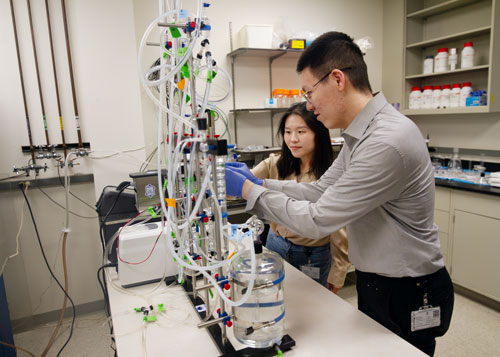The Joint Department Attends 2023 BMES Annual Meeting
Presentations | Posters | About BMES
The 2023 Biomedical Engineering Society Annual Meeting was well attended by members of the Marquette-MCW Joint Department of Biomedical Engineering. Altogether, the Joint Department was represented by 27 faculty, staff and student members, who attended plenary sessions and presented research via posters and presentations. Dr. Brandon Tefft served as organizer for a session entitled, "Navigating the Ethical Landscape: Challenges and Perspectives for International Biomedical Engineers in the U.S. and How We Can All Help." In addition, John (Jack) Seifert, III, a graduate student working at ZVAMC Labs under the direction of Dr. Brian Stemper, won the 2023 Athanasiou Student Paper Award for the lab's review of NCAA-DOD Care Consortium data regarding concussion potential based on frequency of impact, a previously unexamined component of concussion risk. The paper, titled, “Time Delta Head Impact Frequency: An Analysis on Head Impact Exposure in the Lead Up to a Concussion: Findings from the NCAA-DOD Care Consortium,” was chosen for its anticipated impact on the field of Biomedical Engineering, as well as the translational nature of the project. This year's BMES Annual Meeting was held in Seattle, Washington, between October 11th and October 14th.
READ SIEFERT'S PAPER
Presentations
- "Contractility estimated using inverse finite element modeling based on magnetic resonance and 3D echocardiographic images are comparable and correlated." Presented by Dr. Lei Fan, Assistant Professor of Biomedical Engineering.
- "Quantitative Evaluation of Cationic DOTAP-DOPC-DOPE Liposomal-Ceftriaxone Biodistribution and Ototoxicity for Targeted Trans-Tympanic Delivery in an Otitis Media Chinchilla Mode," presented by Shayan Shafiee, PhD Candidate in the Nanomedicine and Image-Guided Interventions Laboratory, working under the direction of Dr. Amit Joshi.
- "Validation of Nanoparticle Mediated Photodynamic Therapy for Drug Resistant Patient Derived Head and Neck Cancer Xenograft Models," presented by Mir Hadi Razeghi Kondelaji, Graduate Student in the Nanomedicine and Image-Guided Interventions Laboratory, working under the direction of Dr. Amit Joshi.
Posters
- "Lumbar Spine Orientation Affects Compressive Fracture Characteristics," presented by Rachel Cutlan, graduate student working under the direction of Dr. Brian Stemper.
- "Mechanism of the Developed Pressure—Preload Relationship in the Isolated Perfused Heart," presented by Dr. Lei Fan, Assistant Professor of Biomedical Engineering.
- "Sex-Based Differences in Goal-Directed Reaching Before and After Training with Supplemental Kinesthetic Vibrotactile Feedback," presented by Mariana E. Guerrero, undergraduate student working under the direction of Dr. Robert Scheidt.
- "The Biomechanics Associated to Failure Properties of the Spinal Endplate," presented by Veruscha Labuschagne, Graduate Student working under the direction of Dr. Brian Stemper.
- "Histological and Mechanical Analysis of Porcine Skin during Puncture Loading," presented by Joe LeSueur, PhD candidate working under the direction of Dr. Frank Pintar.
- "Promoting Functional Arm Movement Via 3-Dimensional Vibrotactile Kinesthetic Training," presented by Rachel (Rocky) Mazorow, PhD candidate working under the direction of Dr. Robert Scheidt.
- "Computational modeling of replication efficiency and late protein synthesis variabilities in HCMV-infected ARPE19 cells," presented by Christopher Monti, MSTP student working under the direction of Dr. Ranjan Dash and Dr. Scott Terhune.
- "Physiologically-based pharmacokinetic computational modeling of sodium fluorescein blood clearance for the assessment of the degree of hepatic ischemia-reperfusion injury," presented by Christopher Monti, MSTP student working under the direction of Dr. Ranjan Dash and Dr. Scott Terhune.
- "Investigating the Effects of an Engineered Hsp104 Chaperone on Protein Aggregation," presented by Nabil Othman, undergraduate student working under the direction of Dr. Robert Scheidt.
- "Longitudinal Changes in MRI Hippocampal Volume are Associated with Post-Stroke Cognitive Decline," presented by Nabil Othman, undergraduate student working under the direction of Dr. Robert Scheidt.
- "Near/Shortwave Infrared Fluorescent Imaging of Vascular Function in the Triple Negative Breast Cancer Tumor Microenvironment with BACH1 Attenuation," presented by Mir Hadi Razeghi Kondelaji, graduate student working under the direction of Dr. Amit Joshi.
- "Leveraging Transfer Learning for Dll4 Expression Assessment in Triple-Negative Breast Cancer: A dynamic enhanced near-infrared Fluorescence Imaging Approach with Time-Series Image Representations," presented by Shayan Shafiee, PhD candidate working under the direction of Dr. Amit Joshi.
- "Comparative Analysis of Machine Learning & Transfer Learning for Personalized Therapy: Assessing Dll4 Heterogeneity in Triple-Negative Breast Cancer via Dynamic Enhanced Near-Infrared Imaging," presented by Shayan Shafiee, PhD candidate working under the direction of Dr. Amit Joshi.
- "Evaluation of force displacement corridors from legform bumper tests and headform hood tests on small U.S. passenger cars," presented by James Wolf, master's student working under the direction of Dr. Frank Pintar.
- "Endothelial cells with low FLRT2 expression exhibit enhanced retention with within vascular grafts," presented by Jayne Wolfe, PhD student working under the direction of Dr. Brandon Tefft.
About the Biomedical Engineering Society
The Biomedical Engineering Society (BMES) was established in 1968 as a professional society for industry professionals, faculty, researchers, and students in biomedical engineering. BMES currently has more than 6,800 members who share its combined mission and vision of health and wellness through engineering innovation while maintaining a steadfast commitment to diversity, equity, inclusion, and belonging. Each year, BMES holds an annual meeting in different cities around the nation where members can network, advocate for innovative solutions, as well as continuing to inspire students and next gen attendees.
View more BME News


